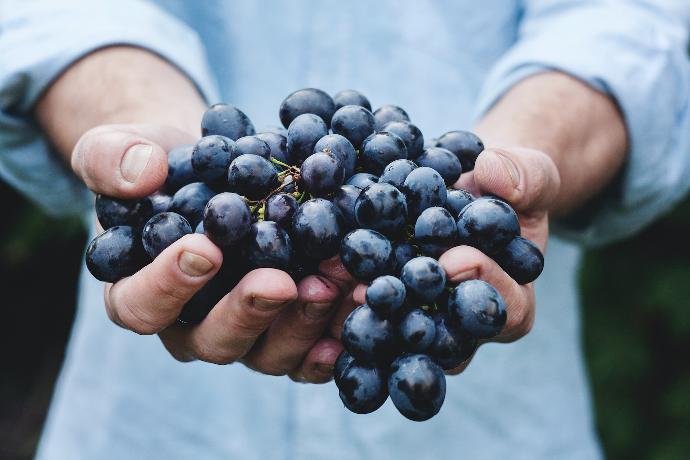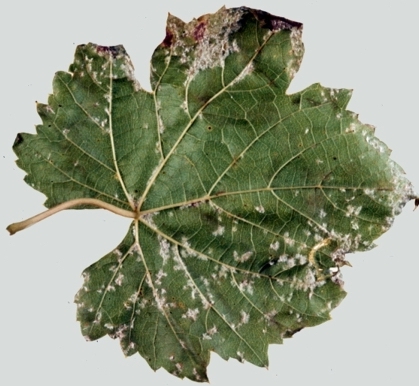Black Grape Plant
Grapevines, 10-20 feet in height and suited for Zones 6-9, grow rapidly in well-drained soil and full sun. Known for their edible fruits, grapes are a popular choice for both fresh consumption and winemaking.

Habit
Vine
Height
1-3 m
Growth
Fast
Soil
Well-drained, loamy
Shade
Full Sun
Moisture
Moderate
Edible
Yes
Medicinal
Yes
Origin
Europe, Asia
Climatic Condition
Temperate
Temperature (°)
15-25°C
Humidity (%)
60-80%
Potting media
Loam + Sand
Fertilizers
Balanced NPK (10:10:10)
Watering
Regular watering
Plant Weight
500-1000 g
Flowering Time
Summer to Fall
Soil Ph level
6.0-7.0
Water Ph level
6.5-7.0
Soil EC
1.0 dS/m
Yield Per Plant
High yield
NPK ratio
10:10:10
life Span
10-30 years
Health Benefits
Antioxidant-rich, heart health
Common Diseases and Remedies
Birds eye spot , Downy mildew
irregular yellowish , translucent spots on lower surface, first as dark red spots on the berry
Timely Pruning , Remove and destroy infected plant parts .
Metalxyl + mancozeb @0.4 % in one litre of water , copperoxychloride@ 0.2 % in 1 litre of water.
HEALTH BENEFITS
· Packed with antioxidants like resveratrol, supporting heart health.
· Improves brain function and reduces inflammation.
· Enhances skin health and protects against premature aging..
What Is An Grape Plant ?
Grapes are the fruits, flowers, and botanically fruits of the deciduous woody vine of the genus Vitis. Grapes are non-climacteric fruits that usually grow in clusters. Grape cultivation began approximately 8,000 years ago and grapes have been used as food throughout history. is a preferred word. Word of mouth. The hanging telegraph was a device used for communication during the Civil War. Since then, people began to refer to the "vine" as a document.

What Are The Different Types Grape Plants?
1) Concord:-
Concord fruit, known for its dark blue-green color, is a popular table fruit. They are used to make juice, jelly, jam and baked goods. Concord grapes are also commonly used to make kosher wine. Berries like this berry are packed with nutrients rich in flavonoid antioxidants and resveratrol, a phenolic compound with anti-cancer, anti-inflammatory and heart-healthy properties.
2) Moon Props:-
Moon Props stands out from other fruits with its unique shape and taste. This black fruit is seedless and has a smooth texture. Their color is dark blue, almost black. They are long with a prominent indentation at one end.
3) Sultana:-
Sultana fruit is one of the oldest fruits. These grapes are small, green-white, very sweet and are also known as Thompson's seedless grapes. Its symptoms make the sultana fruit the preferred fruit, like white raisins. Raisins are grown mostly in California, Australia and Turkey and are harvested between July and September.
4) Kyoho:-
The color of Kyoho fruit is similar to Concord grapes, which show a deep black color. Created by crossing Centennial and Ishihara grapes, this grape has been the most widely grown grape in Japan since 1994. The name Kyoho means "big mountain fruit" and originated on Mount Fuji. Juicy, flavorful meat surrounded by thick skin.
5) Thomcord:-
Blue-green hybrid fruit combines the juice of the plump Concord berry with the sweetness of Thompson seedless or seedless raisin varieties. The fruit is seedless, hard, round and plump and has a unique jam character. Produced in California
6) Red Seedless Grapes:-
This seedless grape has a beautiful dark red color with red skin and green flesh. They are a popular snack due to their delicious and crunchy texture. California breeders developed this variety in 1989. Like other red berries, the anthocyanins in Red berries give them their beautiful color and contribute to the health benefits they provide.
7) Alev Seedless:-
Alev Seedless is a popular fruit loved for its delicious taste. These medium-sized fruits grow in large clusters and are dark red in color. They are sweet and crunchy, with a semi-thick crust.
8) Red Globe Grape:-
Red Globe Grape is a large-seeded fruit used all over the world, especially in Asian countries. The fruit body is hard, crisp and rose red in color. These small fruits are rich in nutrients and beneficial herbs. The large size of red berries makes them a perfect snack, and they can be frozen into ice cubes to help keep drinks cool while making them delicious.

How to care for Grape Plants ?
Like deep, acidic (pH 5.0-6.5), well-drained, sandy soils, but can tolerate most soil types except alkaline and moist. Organic matter content should be between 4-5%, but very fertile soils are not recommended. If the soil is too fertile, the vines will grow too quickly and produce poor fruit.
1. Location
Place in a well-ventilated area as indoor ventilation is inadequate. Planting in plastic containers is also possible, but there is a risk of root rot as the soil does not dry quickly.
2. Sunshine
Vines grow best in full sun; about 7 or 8 hours a day. Insufficient light can cause fruit to be smaller, less attractive, and prone to mold and fruit rot. Vines can grow and produce in many different soil types, but good drainage is crucial. Roots often grow as deep as 15 feet.
3. Soils
Grapes can grow in a variety of soils, including sandy loam, sandy clay loam, red sandy soil, light to medium black soil, and red loam. The soil should be well drained and have good holding capacity, there should be no hard disk or impermeable layer in the upper 90 cm, groundwater should be at least 6.5 m below.
4. Hydration
During the first two years of the growing season, young fruit trees need 1/2 to 1 inch of water per week, depending on rainfall. When watering young vines, saturate the root area. Over 5 gallons of water equals 1 inch of water over a 3 x 3 ft area.

5. Nourishment
The demand for potassium fertilizer is great: the ratio of nitrogen, phosphorus and potassium needed by grapes is 1:0.5:1.2. In addition, fruits have a high demand for magnesium, sulfur, calcium, iron, zinc and manganese.
6. Issues
Spray damage (Phytotoxicity-Leaf burn) Leaf burn. Sulfur, copper, and copper sulfate (Bordeaux mixture) fungicides can burn the foliage of certain grape varieties (Concord). Drought/Environmental Damage. Caused by lack of moisture and hot, dry temperatures.
What are the Benefits of Grape Plant ?
Have anticancer effects , protect against diabetes and lower blood sugar levels , Benefit eye health. May improve memory, attention, and mood. May support bone health . Grape is rich in Vitamin K , Thiamine (vitamin B1) , Riboflavin (vitamin B2) , Vitamin B6 , Potassium , Vitamin C , Manganese , Vitamin E

FAQs About Growing Grape Plant
1) How to care for vines?
Prune vines dormant and reposition buds during the growing season to expose fruit to sunlight and allow good air circulation in the canopy. Pruning and training also helps control gray mold growth. Botrytis fruit rot can develop on dead flowers in inflorescences.
2) What are the uses of grapevine?
The nutrients in fruits may help prevent cancer, eye problems, heart disease and other diseases. Resveratrol is an important component in fruits that may benefit health. Grapes are a good source of fiber, potassium and many other vitamins and minerals.
3) Can fruit be grown indoors?
Although some types of sweet fruit grow well outdoors, they are better grown in glass, even in warm climates. With a little attention to watering, fertilizing, pruning and pruning, it is possible to get a good harvest every year.
4) What is the best pot size for growing grapes?
A large container, at least 15-20 gallons, with drainage in the bottom. Pot dimensions should be 16-18 inches deep and 18-24 inches wide.

